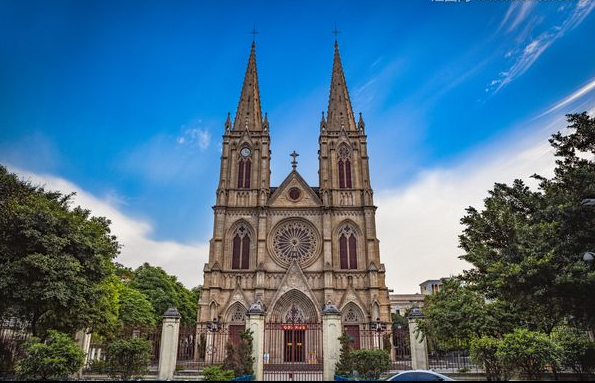In April, a fire at the world-famous Notre Dame Cathedral attracted worldwide attention. In fact, there is also a cathedral in China similar to Notre Dame Cathedral, which is located in Guangzhou Yide Road, the "the Cathedral of the Sacred Heart of Jesus" (also known as the Stone House by locals).
The building is the most majestic church in Guangzhou and was listed as a Major Historical and Cultural Site Protected at the National Level in 1996.
Guangzhou Catholic church was originally under the Diocese of Macau and did not gain independence until 1858. Taken in charge by the Society of Foreign Missions of Paris for the French missionary charter, it was appointed as the initial pontiffs of the Diocese of Guangzhou. As early as 1848, Philippe François Zéphirin Guillemin preached in Guangzhou, and in 1851 he established a small church. During the Second Opium War, the office of the viceroy of Guangdong and Guangxi were destroyed, and the society established the church on that basis. The foundation of the cathedral began on June 28, 1861, which was the day of the feast of the Sacred Heart of Jesus (after which the church was named). Guillemin also specially brought a kilogram of soil from Rome and Jerusalem, symbolizing the foundation of the Catholic Church in Jerusalem, rising from the Western Roman Empire. The inscriptions "JERUSALEM1863" and "ROME1863", respectively under the eastern and western corners of the church, are still clearly visible.
The church was completed in 1863, and on December 8th of the same year, a grand foundation ceremony was held. In addition, the Church gradually set up orphanages, nursery schools, sacred heart colleges, Minder Girls Middle School, Nissin Primary School, San Franciscans Small Convent and Missionary Sisters of the Immaculate Conception, and other ancillary facilities, forming a cluster of believers and Catholic missionary centers in southern China.
With a floor area of 2754 square meters, 35 meters east-west width, 78.69 meters north-south length, and a height of 58.5 meters from the tip to the ground, the Stone House is the largest Gothic-style church in China and southeast Asia, and is the largest stone building in China. Since the church was built entirely with granite, and Guangzhou did not produce granite, the church exhausted the cannabis stone that had been mined from the horns and tea greens of Kowloon, Hong Kong. It took 25 years and was completed in 1888. It took eight years to explore the stone alone. Because the church is made of granite, it is also known as the 'stone room'. Guangzhou Stone House is one of four all-stone Gothic church buildings worldwide (the other three are Notre Dame Cathedral, Westminster Abbey, Cologne Cathedral).
It is worth mentioning that this majestic Gothic church has a lot of Chinese elements. The construction of the whole church made use of the Chinese traditional method of sticky rice with oil instead of cement, rendering the building both waterproof and solid; double holes were drilled into the dome stones with iron branches, making them more solid; the church roof outlet is in the shape of a Chinese lion; the floor was changed from tiles to Guangdong large-size bricks to keep the building dry. Wide-style wood carvings were also engraved on the door.
Historically, the Stone House suffered damages twice, the first was during the Anti-Japanese War, when a Japanese plane crashed into the Bohai Tea House in front of the church and exploded, shattering some of the Napoleon III era stained glass. The other was during the Cultural Revolution. Nevertheless, the main building of the church has been well preserved.
According to media reports, "In July 2004, the renovation of the Stone House began and was completed and reopened in the autumn of 2006. The cost of the overhaul amounted to 20 million yuan. Before the overhaul, only ordinary glass was used to replace the flowery windows; the main task of the restoration was to replace all the windows with specially customized glass from the Philippines, which was 'more expensive than gold', a total of 700 square meters of glass at the cost of 4.3 million yuan. The glass images were based on the stories of the Old Testament, the New Testament, and representing characters depicting about 60 biblical stories, including the birth of Jesus, the baptism of Jesus, and the last supper. A mechanical clock has been reinstalled and is now operational. In addition, the church's stairs, channels and beam frame slabs have been renovated; the interior and exterior granite have been retouched and cleaned by hand; repairs have been carried out on the stone pillars, zenith, altar, notice booth, singing hall, lighting lines, lighting and other indoor configurations."
-Translated by Charlie Li












